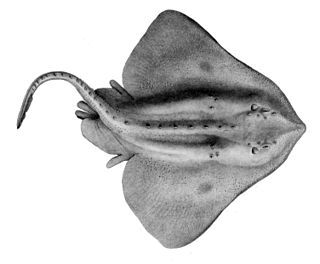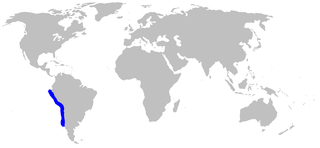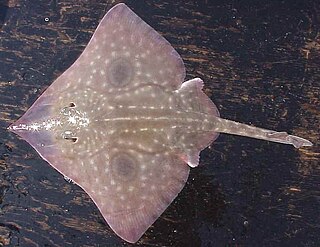
Skates are cartilaginous fish belonging to the family Rajidae in the superorder Batoidea of rays. More than 150 species have been described, in 17 genera. Softnose skates and pygmy skates were previously treated as subfamilies of Rajidae, but are now considered as distinct families. Alternatively, the name "skate" is used to refer to the entire order of Rajiformes.

The hooktooth dogfish, Aculeola nigra, is a small, little-known dogfish, the only member of the genus Aculeola.

The New Zealand smooth skate is a skate of the genus Dipturus, found around New Zealand at depths between 15 and 1,300 m.

The pocket shark is a species of kitefin shark in the family Dalatiidae. The species is found in deep water off Chile in the southeastern Pacific Ocean. It was the only member of the genus Mollisquama, until another species, M. mississippiensis, was discovered in the Gulf of Mexico. Both species are distinguished from other sharks by two pockets next to the front fins. The pockets are large, measuring about 4% of the shark's body length. Some researchers hypothesize that the pockets may excrete some kind of glowing fluid or pheromones.

The bristly catshark is a cat shark of the family Scyliorhinidae, found from southeastern India and the Andaman Islands, between latitudes 15° N and 5° N, at depths between 200 and 300 m. Its length usually ranges from around 20–26 cm, and it is regarded as the smallest catshark of Bythaelurus.

Dipturus is a large genus of skates native to the Pacific, Atlantic, and Indian Oceans. They were formerly included in Raja. Some species initially moved to Dipturus were later placed in Dentiraja, Spiniraja, and Zearaja.
Notoraja is a genus of skates in the family Arhynchobatidae. They are found in deep water in the Indian and western Pacific Ocean.

The barndoor skate is a species of marine cartilaginous fish in the skate family Rajidae of the order Rajiformes. It is native to the northwestern Atlantic Ocean, and is found from the Grand Banks of Newfoundland and the southern side of the Gulf of St. Lawrence south to North Carolina. The fish is one of the largest skates found in the North Atlantic Ocean, reaching lengths up to 1.5 m (5 ft). It is carnivorous, feeding on invertebrates and other fish found near the sea floor.

The common skate, also known as the blue skate, is the largest skate in the world, attaining a length of up to 2.85 m (9.4 ft). Historically, it was one of the most abundant skates in the northeast Atlantic Ocean and the Mediterranean Sea. Despite its name, today it appears to be absent from much of this range. Where previously abundant, fisheries directly targeted this skate and elsewhere it is caught incidentally as bycatch. The species was uplisted to critically endangered on the IUCN Red List in 2006 and it is protected within the EU.

The big skate is the largest species of skate in the waters off North America. They are found along the Pacific Coast from Alaska to Baja California, typically from the intertidal zone to a depth of 120 m (390 ft), and feed on benthic invertebrates and small fishes. They are unusual among skates in that their egg cases may contain up to seven eggs each. This species is one of the most commercially important skates off California and is sold for food.
Enteroctopus megalocyathus, also known as the southern red octopus, is a medium-sized octopus, and the type species for the genus Enteroctopus.
Tarsistes philippii is a taxonomically dubious species of guitarfish, family Rhinobatidae. It is known only from a dried head from the Juan Fernández Islands off Chile. The head had a long, thin, flat snout, rounded at the tip like that of the goblin shark, and the underside covered with small stellate prickles except for the base. The head was covered with larger spinules, with six still larger ones forming a curve around the eye.
Broadnose skate is a species of skate in the family Arhynchobatidae. This fish occurs on 28 to 604 meters, mostly at depths shallower than 250 meters, from Valdivia and Estrecho de Magallanes to Argentina and the Falkland Islands. It has the maximum total length of about 125 centimeters which it reaches in about 20 years. Both sexes reach maturity at age 8–10 years.
The Peruvian skate is a large skate found in the southeast Pacific Ocean, off the coasts of Peru, Ecuador, and Chile. It can grow to an estimated 1.1 metres total length, and 1.25 m across. It is known to be a deepwater species; the holotype was caught at a depth of 908 m (2,979 ft), and is generally found at depths of 600–1,100 m (2,000–3,600 ft). Very little is known about its biology.

The graytail skate, or gray tail skate, is a large species of skate in the family Arhynchobatidae, native to the south-western Atlantic Ocean and south-eastern Pacific Ocean. It is listed as endangered by the IUCN. It was caught as part of a commercial fishery around the Falkland Islands and is a bycatch in several other fisheries.

Tonicia is a genus of chitons in the family Chitonidae. The genus was recently restricted to include only 12 New World species, with the more species-rich and exclusively Old World subgenus Lucilina Dall, 1882, being elevated to a separate genus. Of these 12, ten species are found in the eastern Pacific, one in the Magellan province and one in the Caribbean Sea . However, a study published in 2019 which used molecular systematics to compare the eastern Pacific Tonicia species suggested that there are only 9 extant species in the eastern Pacific.
The Norwegian skate, or black skate, is a species of skate found at depths of 200 m (660 ft) to over 1,000 m (3,300 ft) in the East Atlantic region. Initially its range was believed to be restricted to the Norwegian Sea and North Sea to the Bay of Biscay. It is occasionally encountered off the western coast of Ireland, and historically has been found near Rockall and in the Norwegian Deep, though recent surveys have not identified the species there. The species has frequently been confused with other skates, and since the late 1980s it has been confirmed to occur more widely, ranging from Iceland to Morocco, as well as off South Africa and in the Mediterranean Sea.
Dipturus teevani, commonly known as the prickly brown ray or Caribbean skate, is a species of cartilaginous fish in the family Rajidae. The prickly brown ray is medium in size compared to other skates, and is known from a patchy, deep-water distribution in the western Atlantic Ocean.

Fishing in the Falkland Islands contributes to the local economy. Fish species range from golden sea tench to the rare triple tail shark. The official body responsible for the sustainable development of fisheries in the Falklands is the Falkland Islands Fisheries Department (FIS), established in 1987, It is reported that during 2013 the Loligo fishery had the best results.
Julio Lamilla was a Chilean biologist, researcher and conservationist. Lamilla was a former student of Liceo Armando Robles Rivera in Valdivia before graduating from the Austral University of Chile in Biology and Chemistry in which he majored in Zoology.











